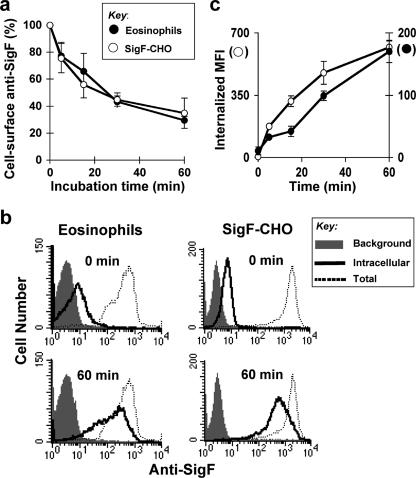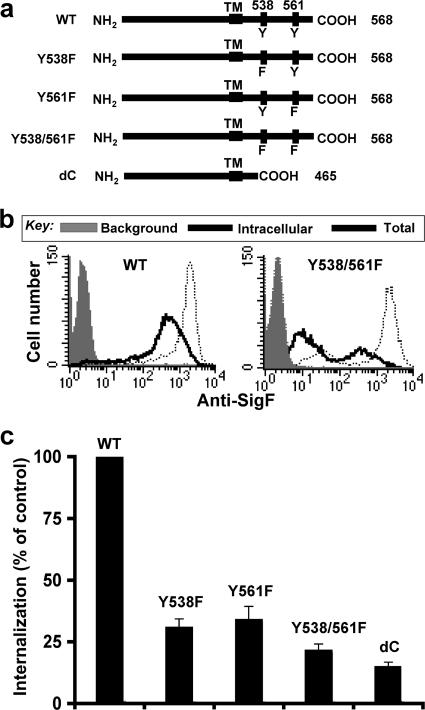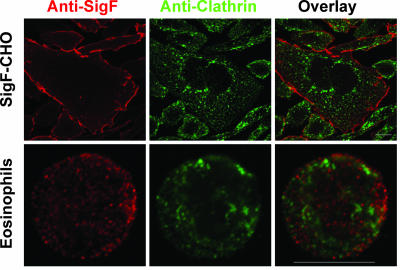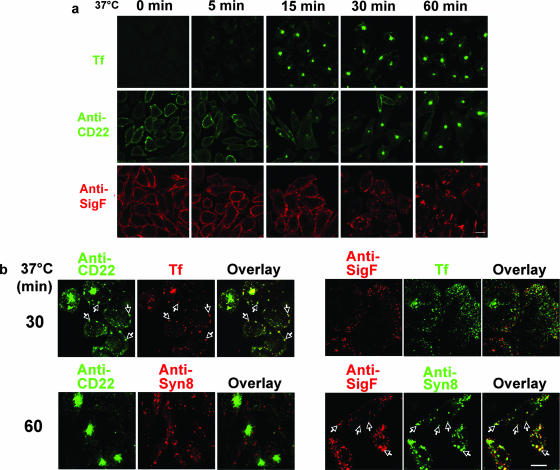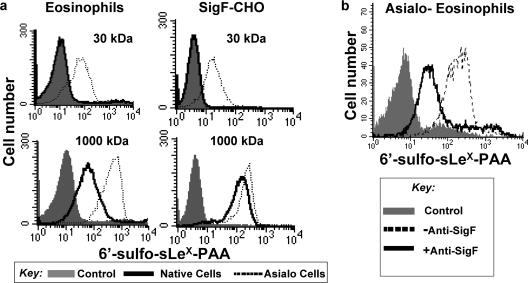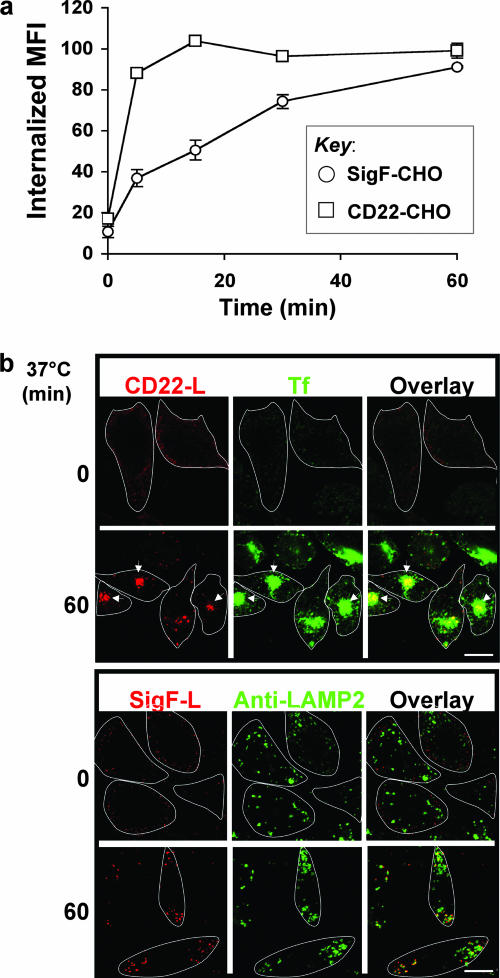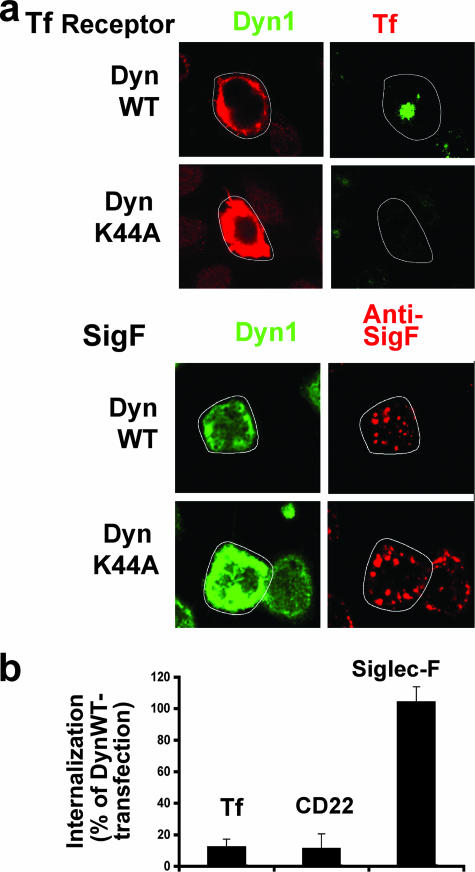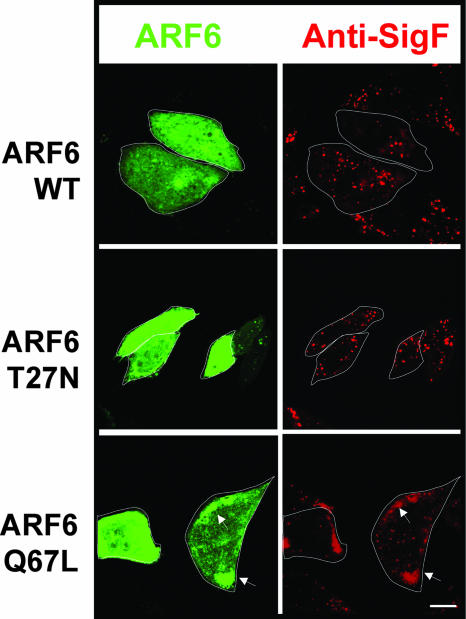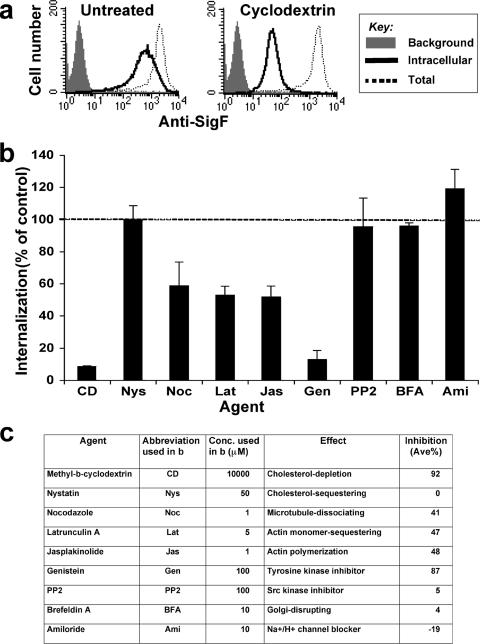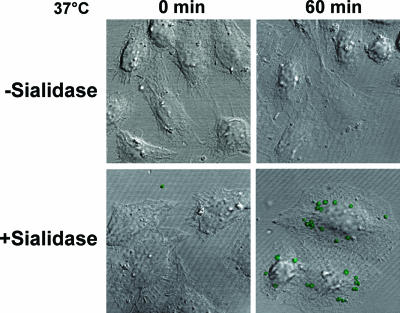Abstract
Sialic acid-binding immunoglobulin-like lectins (siglecs) are predominately expressed on immune cells. They are best known as regulators of cell signaling mediated by cytoplasmic tyrosine motifs and are increasingly recognized as receptors for pathogens that bear sialic acid-containing glycans. Most siglec proteins undergo endocytosis, an activity tied to their roles in cell signaling and innate immunity. Here, we investigate the endocytic pathways of two siglec proteins, CD22 (Siglec-2), a regulator of B-cell signaling, and mouse eosinophil Siglec-F, a member of the rapidly evolving CD33-related siglec subfamily that are expressed on cells of the innate immune system. CD22 exhibits hallmarks of clathrin-mediated endocytosis and traffics to recycling compartments, consistent with previous reports demonstrating its localization to clathrin domains. Like CD22, Siglec-F mediates endocytosis of anti-Siglec-F and sialoside ligands, a function requiring intact tyrosine-based motifs. In contrast, however, we find that Siglec-F endocytosis is clathrin and dynamin independent, requires ADP ribosylation factor 6, and traffics to lysosomes. The results suggest that these two siglec proteins have evolved distinct endocytic mechanisms consistent with roles in cell signaling and innate immunity.
The siglec (sialic-acid binding immunoglobulin [Ig]-like lectins) proteins are subset of the Ig superfamily of cell recognition molecules that bind to sialic acid-containing glycans of cell surface glycoconjugates as ligands (27, 78). Of the 13 human and 9 murine siglec proteins, 4 are highly conserved in mammalian species: sialoadhesin (Sn)/Siglec-1, CD22/Siglec-2, myelin-associated glycoprotein (MAG)/Siglec-4, and Siglec-15. The others comprise a rapidly evolving subfamily homologous to CD33/Siglec-4, known as the CD33-related siglec proteins. With two exceptions (MAG and Siglec-6) the siglec proteins are predominantly expressed in various white blood cells of the immune system (25, 43, 78, 85). All contain a N-terminal V-set sugar-binding Ig domain, a variable number of additional C-set Ig domains, a transmembrane domain, and a cytoplasmic domain that typically contains tyrosine-based motifs implicated in regulation of cell signaling and endocytosis.
Many of the siglec proteins contain one or more immunoreceptor tyrosine-based inhibitory motifs (ITIMs), (I/L/V)XYXX(L/V), suggesting that they play important roles as inhibitory receptors of cell signaling (25, 78), as exemplified by CD22, which is well documented as a regulator of B-cell receptor (BCR) signaling. Upon antigen binding to the BCR, the ITIMs of CD22 are quickly tyrosine phosphorylated and recruit protein tyrosine phosphatase SHP-1, which dephosphorylates the BCR and dampens the B-cell response, setting a threshold for B-cell activation (27, 73).
CD22 is also known to undergo endocytosis following ligation by anti-CD22 antibody (38, 64) or high-affinity multivalent-sialoside ligands (22). The tyrosine-based ITIMs of CD22 also fit the sorting signal YXXØ (where Ø is a hydrophobic residue) for association with the adaptor complex 2 (AP2), which directs recruitment of receptors into clathrin-coated pits (13). John et al. reported that CD22 associates with the AP50 subunit of AP2 through these tyrosine-based motifs and that they are required for endocytosis (37). Consistent with this observation, CD22 is predominantly localized in clathrin-rich domains (23, 34). Antigen ligation of the BCR results in mobilization of the BCR to “activation rafts,” which subsequently fuse with clathrin domains prior to endocytosis (69, 70). Since CD22 is specifically excluded from activation rafts (54), the negative regulatory effect of CD22 on BCR signaling has been proposed to occur following its movement to clathrin domains (23), linking the endocytic activity of CD22 to its role in regulation of BCR signaling.
Sn and most CD33-related siglec proteins are expressed on cells of the innate immune system, including monocytes, macrophages, neutrophils, eosinophils, and dendritic cells (25, 43, 50, 85), focusing investigations into their precise functions on the known activities of these cells. Like CD22, ligation of CD33-related siglec proteins (CD33 and Siglec-5, -7, and -9) also induces recruitment of SHP-1 via phosphorylated ITIMs (6, 7, 53, 72). Antibody ligation of the same siglec proteins initiates their endocytosis, suggesting that endocytic activity is also a general property of this subfamily (9, 38, 50, 81, 84). Over 20 pathogenic microorganisms express sialic acid-containing glycans on their surface (25). Recent demonstration of the binding or uptake of several sialylated pathogens, including Neisseria meningitidis, Trypanosoma cruzi, Campylobacter jejuni, and group B Streptococcus, by Sn and Siglec-5, -7, and -9 has suggested various roles of these siglec proteins in the immune responses to these organisms (8, 18, 25, 30, 38, 45). Since mechanisms of pathogen entry and engulfment are increasingly recognized to involve the host cells' endocytic machinery (12), the endocytic functions of the siglec proteins are also relevant to their roles in pathogen recognition and uptake.
In this report, we contrast the mechanisms of endocytosis of CD22 and a CD33-related siglec, murine Siglec-F, predominately expressed on eosinophils (85). Eosinophils are best known for their role in allergic diseases (62). In this regard, a recent report analyzing Siglec-F null mice revealed enhanced eosinophil infiltration and blood eosinophilia in response to allergen challenge, suggesting that Siglec-F is a negative regulator of eosinophil response to allergens (86). Eosinophils also contribute to an immune response against foreign pathogens, including binding, engulfment, and killing of microbes (1, 15, 19, 32, 36, 83). While investigating the endocytic activity of Siglec-F, we observed efficient endocytosis of anti-Siglec antibody, high-affinity sialoside ligand probes, and Neisseria meningitidis bearing sialylated glycans. Like CD22, endocytosis was dependent on its cytoplasmic ITIM and ITIM-like motifs. Surprisingly, however, Siglec-F exhibited no colocalization with clathrin, raising doubt that it was endocytosed by a clathrin-mediated mechanism, as proposed for CD22. More detailed investigations showed that while endocytosis of CD22 is indeed mediated by a clathrin-dependent mechanism and is sorted to early endosome and recycling compartments, Siglec-F endocytosis is directed to lysosomal compartments and is mediated by a mechanism that is independent of clathrin and dynamin. The results suggest that siglec proteins have evolved different mechanisms of endocytosis consistent with roles in regulation of cell signaling and innate immunity.
MATERIALS AND METHODS
Antibodies and reagents.
Purified rat anti-Siglec-F (E50-2440), phycoerythrin (PE)-conjugated anti-Siglec-F (E50-2440), fluorescein isothiocyanate (FITC)-conjugated anti-human CD22 (HIB22), PE-Cy5-streptavidin, anti-Syntaxin-8 (48), and anti-EEA1 (14 polyclonal antibodies) were purchased from BD Biosciences-Pharmingen (San Diego, CA). Anti-hamster LAMP2 (UH3) was purchased from the Developmental Studies Hybridoma Bank. Anti-clathrin heavy chain (x22) was purchased from Abcam. Affinity-purified sheep anti-Siglec-F IgG was prepared as described previously (85). Alexa Fluor 488 (AF488)- and AF555-goat anti-mouse IgG, AF555-anti-mouse IgG1, and AF555-anti-mouse IgG2a, AF555-conjugated goat anti-rat IgG, AF555-goat anti-rabbit IgG, Quantumdot 655 (Qdot655)-streptavidin, and AF488-streptavidin were purchased from Invitrogen. FITC-donkey anti-sheep IgG and FITC-donkey anti-rabbit IgG were purchased from Jackson Immunoresearch (West Grove, PA). Anti-CD45 and anti-CD90 antibody-conjugated magnetic beads were purchased from Miltenyi Biotech (Auburn, CA).
Synthesis of high-molecular-mass sialoside-PAA probe.
Biotinylated low-molecular-mass (30 kDa) sialoside-polyacrylamide (PAA) conjugates bearing Neu5Acα2-3[6-SO4]Galβ1-4[Fucα1-3]GlcNAc (6′-sulfo-sLeX) or 9-biphenylcarbonyl (BPC)-Neu5Acα2-6Galβ1-4GlcNAc were synthesized by coupling spacered oligosaccharides and spacered biotin to poly (4-nitrophenyl acrylate) as described previously (16) Biotinylated high-molecular-mass (1,000 kDa) PAA conjugates were synthesized by coupling spacered oligosaccharides and spacered biotin to poly (N-oxysuccinimide acrylate) as described previously (67); the 1,000-kDa lactose conjugate was obtained from The Consortium for Functional Glycomics.
Mice.
The IL5 transgenic (IL5-Tg) mouse line NJ.1638 was the generous gift of James J. Lee (Mayo Clinic, Scottsdale, AZ) (41). C57BL/6 mice were obtained from the Scripps Research Institute. Protocols were conducted in accordance with the National Institutes of Health and the Scripps Research Institute.
Plasmids.
The full-length cDNA fragment of Siglec-F and human CD22 was amplified by PCR and cloned into pcDNA5/FRT/V5-His vector (Invitrogen) (71). Site-directed mutagenesis was performed using a Genetailor site-directed mutagenesis system (Invitrogen). The primers used for construction of Siglec-F mutants were as follows: for T535F, 5′-GGATGAGCCTGAACTCCACTTTGCCTCCCTC-3′ (sense) and 5′-GGATGAGCCTGAACTCCACTTTGCCTCCCTC-3′ (antisense); for T568F, 5′-GGAGGCTATGAAATCTGTATTCACAGACATC-3′ (sense) and 5′-TACAGATTTCATAGCCTCCGTGTTCTGAG-3′ (antisense); and for the cytoplasmic tail deletion, dC, 5′-TTTTCACAGTGAAGGTCCTCTGATAGAAATCAGCCC-3′ (sense) and 5′-GAGGACCTTCACTGTGAAAAAGATGAGGCA-3′ (antisense). Dynamin-1 cDNA constructs (wild type [WT] and K44A) were obtained from Sandra L. Schmid (The Scripps Research Institute, San Diego, CA). ADP ribosylation factor 6 (ARF6)-enhanced green fluorescent protein (EGFP) cDNA constructs (WT, T27N, and Q67L) were obtained from Julie G. Donaldson (National Institutes of Health, Bethesda, MD). Cells were grown to 70 to 80% confluence on coverslips and transiently transfected with plasmid using Lipofectamine 2000 (Invitrogen).
Cell culture.
CHO cells were cultured in Ham's F-12 medium, respectively, supplemented with 10% fetal calf serum, penicillin (100 U/ml), and streptomycin (100 μg/ml). Stable clones of CHO cells expressing Siglec-F, Siglec-F mutants, and human CD22 were generated by Lipofectamine 2000 (Invitrogen) and selection in 0.5 mg/ml hygromycin B (Roche Molecular Biochemicals).
Agent treatments.
Cells were preincubated for 30 min at 37°C in Ham's F-12-10% fetal calf serum medium containing 10 mM methyl-β-cyclodextrin (CD) (Sigma-Aldrich), 5 μM latrunculin A (Sigma-Aldrich), 1 μM jasplakinolide (EMD Biosciences, CA), 100 μM genistein (Sigma-Aldrich), 100 μM PP2 (EMD Biosciences), 100 μM sodium pervanadate, 1 μM nocodazole (Sigma-Aldrich), 10 μM amiloride (Sigma-Aldrich), 50 μM nystatin (Sigma-Aldrich), or 10 μM brefeldin A (Sigma-Aldrich). Cells were then incubated with PE-anti-Siglec-F in the continued presence of the agents at 37°C for 1 h. Agent treatment did not affect cell viability.
Flow cytometry.
Cells (5 × 105) suspended in PBS/BSA (10 mM phosphate-buffered saline [pH 7.0] containing 10 mg/ml bovine serum albumin) were incubated with 10 μg/ml of primary antibody or sialoside-PAA probe for 30 min on ice. After washing with PBS/BSA, cells were incubated with 10 μg/ml of FITC-secondary antibody or streptavidin-Cy5-PE for 30 min on ice. For sialidase pretreatment, cells in PBS/BSA were incubated with 25 mU of A. ureafaciens sialidase (Roche Molecular Biochemicals) for 30 min at 37°C. Flow cytometry data were acquired on a FACS Calibur flow cytometer (BD Biosciences, San Jose, CA) and analyzed using the CellQuest software.
Immunofluorescence microscopy.
For the internalization assay, CHO cells cultured on coverslips for 2 days were labeled with fluorescence-conjugated antibody (10 μg/ml) in PBS/BSA for 30 min on ice. Cells were then incubated at 37°C for various times, and internalization was stopped by transferring the cells to ice. After washing, cells were fixed with 4% paraformaldehyde (PFA; Electron Microscopy Services) for 15 min at room temperature. For colocalization experiments, cells were further permeabilized with 0.1% saponin in PBS for 20 min at room temperature and then incubated with the desired antibody for 1 h at room temperature or 4°C overnight.
For eosinophil staining, eosinophils from IL5-Tg mice at 107/ml in PBS/BSA were fixed with 2% PFA for 10 min at 4°C before staining with the desired antibodies for 30 min at 4°C. After cell surface staining, cells were cytospun onto glass slides and fixed with 4% PFA for 20 min at room temperature. Cells were further permeabilized with 0.1% saponin in PBS for 20 min at room temperature and then incubated with anticlathrin antibody (clone x22). Cells were mounted with Prolong gold antifade reagent (Invitrogen) and examined using a Zeiss Axiovert S100TV microscope equipped with a Bio-Rad MRC 1024 confocal laser scanner. Images were collected with Bio-Rad LaserSharp 2000 software and analyzed with Image J (v. 1.33), Zeiss LSM image, and Adobe Photoshop.
Bacteria.
Cells of Neisseria meningitidis MC58 (NRCC 6200 Cap+ and NRCC 4728 Cap−) were grown on chocolate agar in the presence of 20 μg/ml CMP-NeuAc to increase the level of sialylation of the lipooligosaccharide (LOS). The cells were killed by heat treatment at 68°C for 1 h. The killed cells were labeled with FITC by resuspending them first in PBS and then mixing them with 1 mg/ml FITC in sodium bicarbonate buffer at pH 9. Cells were reacted with the dye for 15 min and then washed extensively. Cells were observed by phase-contrast microscopy to ensure they were intact and to estimate the cell number.
RESULTS
Endocytosis of Siglec-F following ligation by antibody.
Endocytosis of Siglec-F was assessed by monitoring the decrease of anti-Siglec-F from the surface of eosinophils using flow cytometry. Siglec-F was labeled with sheep anti-Siglec-F on ice for 30 min. The temperature was raised to 37°C to initiate endocytosis, and at various times, cells were transferred to 4°C. Residual cell-surface anti-Siglec-F was then detected by incubation with FITC-anti-sheep IgG. As shown in Fig. 1a, anti-Siglec-F was internalized over time, reaching ∼60% internalization relative to time zero after 30 min.
FIG. 1.
Siglec-F mediates endocytosis following ligation by antibody. (a) SigF-CHO cells and mouse eosinophils were incubated with sheep anti-Siglec-F pAb on ice for 30 min and allowed to internalize at 37°C for the indicated time. Cell-surface anti-Siglec-F pAb was detected by FITC-anti-sheep IgG. Data are the average ± standard deviation of three independent experiments. (b) SigF-CHO cells and mouse eosinophils were incubated with PE-anti-Siglec-F (dotted line and solid line) or isotype control (shaded) for 30 min on ice. After washing, the cells were allowed to internalize at 37°C for the indicated time. Following the incubation, cells were washed with 0.2 M glycine buffer pH 2.0 (solid line, intracellular) to remove surface-bound antibody or PBS/BSA (shaded area and dotted line, total probe) as a control. Bound or internalized antibody was measured by flow cytometry. Representative results are shown. (c) Data are expressed as internalized mean fluorescence intensity (MFI) of PE-anti-Siglec-F measured as in panel b. Data are the average ± standard deviation of triplicate determinants.
CHO cells are often used to study the mechanism of endocytosis of immunoreceptors (14, 39, 68). Anti-Siglec-F bound to CHO cells stably expressing Siglec-F (SigF-CHO) was internalized at a rate similar to that observed for eosinophils (Fig. 1). Anti-CD22 monoclonal antibody (MAb) was similarly internalized from the cell surface of CD22-CHO cells, with 50% internalization observed within 30 min (data not shown).
The endocytosis of Siglec-F was also assessed by monitoring the internalization of fluorescently labeled anti-Siglec-F MAb. Eosinophils or SigF-CHO cells were stained with PE-anti-Siglec-F MAb at 4°C and warmed to 37°C for up to 60 min. Cell-associated antibody was monitored by flow cytometry before (total) or after removing residual cell surface antibody by a brief low-pH wash. After incubation at 37°C for 60 min, the level of intracellular PE-anti-Siglec-F MAb increased gradually over time (Fig. 1b and c). The combined results demonstrate that antibody ligation initiates efficient endocytosis of Siglec-F on both mouse eosinophils and SigF-CHO cells.
Mutation of tyrosines 538 and 561 abrogates endocytosis of Siglec-F.
Siglec-F carries two potential cytoplasmic tyrosine-based sorting motifs (YxxL/I) at amino acids Tyr 538 and 561. To assess whether the intact motifs are required for internalization, we designed mutant constructs substituting phenylalanine for tyrosine 538 and 561, either individually or in combination, and a cytoplasmic deletion mutant (Fig. 2a). The internalization of the mutant Siglec-F constructs was compared to that of WT Siglec-F by flow cytometry. Although PE-anti-Siglec-F MAb was efficiently internalized in CHO cells expressing WT Siglec-F, the level of internalized antibody was significantly decreased in CHO cells expressing the double-tyrosine mutant Y538/561F (Fig. 2b). Mutation of both tyrosines to phenylalanine reduced internalization by nearly 80% (Fig. 2c). The inhibitory effect of the cytoplasmic deletion mutant is similar to that of the double-tyrosine mutant Y538/561F (85% inhibition), suggesting that the tyrosine-based motifs are dominant sorting signals. Since mutation of either Tyr538 or Tyr561 also inhibited (66 to ∼69%) endocytosis of Siglec-F, we conclude that both tyrosine-based motifs are required for optimal endocytosis of Siglec-F. In contrast to the mutations in the cytoplasmic domain, an Arg-to-Ala mutation of the conserved arginine residue required for sialoside binding (3) showed no effect on internalization of Siglec-F, suggesting that ligand-binding activity is not directly involved in the endocytosis of Siglec-F (data not shown), as reported previously for endocytosis of CD22 (87).
FIG. 2.
Tyrosine-based motifs are required for endocytosis of Siglec-F. (a) Schematic representation of WT and mutant forms of Siglec-F. The sequence at the C-terminal end is 431 SETSRGTVLGAIWGAGMALLAVCLCLIFFTVKVLRKKSALKVAATKGNHLAKNPASTINSASITSSNIALGYPIQGHLNEPGSQTQKEQPPLATVPDTQKDEPELHYASLSFQGPMPPKPQNTEAMKSVYTEIKIHKC 569, where underlined letters are the transmembrane domain and tyrosines 538 and 561 are in boldface. (b) Rates of internalization of Siglec-F for CHO cells stably expressing WT and mutant forms of Siglec-F were compared as in Fig. 1b. Representative flow cytometry data of the WT and the double-tyrosine mutant (Y538/561F) of Siglec-F are shown. (c) Percent internalization is calculated as (intracellular mean fluorescence intensity [MFI]/total MFI) × 100 and expressed as a percentage of internalization in CHO cells expressing wild-type Siglec-F. Data are the average ± standard deviation of triplicate determinants.
Siglec-F is not colocalized with clathrin domains.
Since the Siglec-F tyrosine-based motifs (YxxI/L) conform to the binding sites for clathrin-associated adapter complex 2 (AP2) and CD22 had previously been demonstrated to localize predominantly in clathrin domains (23), we investigated the localization of clathrin and Siglec-F on mouse eosinophils and SigF-CHO cells. Fixed cells were first stained with anti-Siglec-F MAb and AF555-labeled (60) anti-rat IgG. Cells were then permeabilized and stained with anti-clathrin MAb and AF488-labeled (green) anti-mouse IgG. As shown in Fig. 3, on both mouse eosinophils and SigF-CHO cells anti-Siglec-F staining appeared punctate and did not overlap with anticlathrin staining. Staining of mouse eosinophils or SigF-CHO cells with anti-Siglec-F and secondary antibody prior to fixation and permeabilization also showed no association with clathrin (data not shown).
FIG. 3.
Siglec-F is not colocalized with clathrin. SigF-CHO cells or mouse eosinophils were fixed with 2% PFA before staining with mouse anti-Siglec-F MAb and AF555-anti-rat IgG. After permeabilization, cells were stained with mouse anti-clathrin MAb and AF488-anti-mouse IgG and examined by confocal microscopy. Representative images are shown. Bars, 10 μm.
Endocytosis of Siglec-F and CD22 results in sorting to different intracellular compartments.
To further assess the absence of Siglec-F and clathrin localization, the internalization of Siglec-F was followed by confocal fluorescence microscopy and compared to that of CD22 and transferrin (Tf) receptor, which is known to be mediated by a clathrin-mediated mechanism (46). SigF-CHO, CD22-CHO, and parental CHO cells were grown on coverslips and were labeled with PE-anti- Siglec-F MAb, FITC-anti-CD22 MAb, and AF488-Tf, respectively, and allowed to internalize at 37°C for various times over a 60-min period. Slides were then fixed for microscopy. As shown in Fig. 4a, all three proteins were diffusely localized at time zero (4°C). Within 15 min of warming to 37°C, Tf was clearly observed in early endosomes and the tubules of the recycling compartment, visible as a bright spot near the nucleus as reported previously (46). CD22 exhibited visually identical localization as the Tf receptor with slightly delayed kinetics. In contrast, anti-Siglec-F endocytosed at a much reduced rate and accumulated in intracellular compartments with a lysosomal appearance visually distinct from Tf and anti-CD22 staining. The labeling at 60 min was a result of intracellular staining for all three proteins since there was no change in appearance if cells were subjected to a low-pH wash (0.2 M glycine, pH 2.0) prior to fixation.
FIG. 4.
Endocytosis of Siglec-F and CD22 results in sorting to different intracellular compartments. (a) CD22-CHO and SigF-CHO cells grown on coverslips were labeled with FITC-anti-CD22 and PE-anti-Siglec-F on ice for 30 min, respectively, and allowed to internalize after shifting to 37°C for the indicated times. As a control, internalization of Tf is shown. (b) Cells were incubated with antibody (FITC-anti-CD22 or PE-anti-Siglec-F) and Tf (AF555-Tf or AF488-Tf) on ice for 30 min and allowed to internalize after shifting to 37°C for 30 min. Cells were also stained with a lysosome marker, anti-Syntaxin-8. Representative images are shown. Bars, 10 μm.
To better characterize the intracellular localization of endocytosed CD22 and Siglec-F, we investigated their localization in relationship to Tf, a marker for the early endosome and recycling compartments, and anti-Syntaxin-8, a marker for late endosomes and lysosomes (5, 55, 76). As expected, CD22 was predominantly colocalized with Tf in early endosomes and recycling compartments, with negligible colocalization with the lysosomal marker Syntaxin-8 (Fig. 4b). The results are consistent with endocytosis occurring by a clathrin-mediated mechanism. In contrast, anti-Siglec-F was predominantly colocalized with anti-Syntaxin-8 and another lysosomal marker, anti-LAMP2 (not shown), and exhibited minimal colocalization with Tf. Endocytosed anti-Siglec-F also partially colocalized with the early endosomal marker anti-EEA-1 but not with anti-clathrin or anti-AP2 (data not shown). The results indicate that Siglec-F and CD22 are sorted to different intracellular compartments, with Siglec-F being predominantly sorted to lysosomes.
The effect of tyrosine-based motifs on endocytosis of Siglec-F was confirmed by confocal fluorescence microscopy. While anti-Siglec-F showed predominantly intracellular punctate staining in CHO cells expressing WT Siglec-F, cells expressing the double-tyrosine mutant (Y538/561F) showed only diffuse surface staining that was removed with a brief low-pH wash (not shown).
A high-affinity sialoside probe competes with cis ligands and binds to Siglec-F on native cells.
Recently, Collins et al. showed that high-affinity sialoside ligands could compete with cis ligands, bind to CD22 on native B cells, and serve as a ligand-based marker of CD22 endocytosis (22). The ligand was comprised of a high-affinity synthetic ligand of CD22, 9-biphenylcarboxyl-NeuAcα2-6Galβ1-4GlcNAc (BPC-NeuAc-LN), attached to a 1,000-kDa PAA (74) backbone. To determine if CD22 and Siglec-F carry sialoside ligands to the same compartments as their respective anti-siglec antibodies, we sought to prepare an analogous sialoside ligand for Siglec-F. We previously reported that the preferred glycan ligand for Siglec-F is 6′-sulfo-sLeX (Neu5Acα2-3[6-SO4]Galβ1-4[Fucα1-3]GlcNAc) (71). However, Siglec-F appears to be masked to synthetic 30-kDa PAA probes containing this sequence unless the cells are treated with sialidase to destroy cis ligands, a general property of the siglec family (25, 47, 58, 59, 78). To create high-avidity probes for Siglec-F, 6′-sulfo-sLeX was attached to the 1,000-kDa-molecular-mass PAA along with 5% biotin to allow detection with streptavidin (74). A standard enzyme-linked immunosorbent assay using immobilized Siglec-F-Fc chimera showed that the resulting 1,000-kDa 6′-sulfo-sLeX-PAA probe bound with much higher binding avidity than did the standard 30-kDa 6′-sulfo-sLeX-PAA probe (data not shown), indicating that the increased multivalency did increase binding avidity for Siglec-F. The 6′-sulfo-sLeX-PAA probes (30 kDa and 1,000 kDa) were then compared for their abilities to compete with cis ligands and bind to native eosinophils and SigF-CHO cells, as illustrated in Fig. 5a. As found earlier, the 30-kDa probe failed to bind to native cells but bound only to the sialidase-treated (asialo) cells (71). In contrast, the 1,000-kDa probe bound to native cells as well, demonstrating that the 1,000-kDa 6′-sulfo-sLeX-PAA probe can effectively compete with cis ligands on both mouse eosinophils and SigF-CHO cells. Blocking with anti-Siglec-F MAb inhibited binding of the sialoside probe to the cells (Fig. 5b), indicating that the binding is not due to a nonspecific interaction (71). No binding of a control 1,000-kDa lactose-PAA probe was observed.
FIG. 5.
High-molecular-mass sialoside probe binds to Siglec-F on native cells. (a) Mouse eosinophils prepared from IL5-Tg mice or SigF-CHO cells pretreated with or without A. ureafaciens sialidase were incubated with biotinylated 1,000-kDa lactose-PAA (negative control) or 1,000-kDa 6′-sulfo-sLeX-PAA probe on ice for 60 min. After washing, bound probe was detected with PE-Cy5-streptavidin and analyzed by flow cytometry. (b) Sialidase-treated mouse eosinophils were preincubated with or without anti-Siglec-F MAb and then were incubated with the biotinylated sialoside-PAA probes on ice for 60 min. After washing, bound probe was detected with PE-Cy5-streptavidin and analyzed by flow cytometry.
Siglec-F and CD22 mediate endocytosis of glycan ligands to different subcellular compartments.
Using the high-affinity sialoside probes that can bind to Siglec-F and CD22 on native cells, we compared their abilities to internalize and traffic their respective sialoside probes to intracellular compartments (Fig. 6). Cells were incubated with the appropriate 1,000-kDa biotinylated sialoside-PAA probe on ice for 60 min followed by incubation with PE-Cy5-streptavidin on ice for an additional 30 min. The cells were then shifted to 37°C, and the degree of probe internalization assessed before and after low-pH wash was measured by flow cytometry at various times. As shown in Fig. 6a, CD22-CHO cells efficiently internalized the BPC-NeuAc-LN-PAA probe. Similarly, the 6′-sulfo-sLeX-PAA probe was internalized by Siglec-F on SigF-CHO cells with somewhat slower kinetics, as seen for the anti-Siglec-F antibody (Fig. 3). No binding or internalization was observed with the control 1,000-kDa lactose-PAA by either CD22-CHO or Siglec-F-CHO cells (data not shown). No binding or internalization was observed for either the 1,000-kDa BPC-NeuAc-LN-PAA or 6′-sulfo-sLeX-PAA probe with untransfected CHO cells (data not shown).
FIG. 6.
Siglec-F and CD22 mediate endocytosis of glycan ligands. (a) SigF-CHO cells or CD22-CHO cells were incubated with the 1,000-kDa 6′-sulfo-sLeX-PAA probe and the 1,000-kDa BPC-NeuAc-LN-PAA probe on ice for 60 min followed by incubation with PE-Cy5-streptavidin on ice for 30 min. After washing, the cells were then shifted to 37°C for the indicated times. Following the incubation, cells were washed with 0.2 M glycine buffer, pH 2.0, to remove surface-bound probe or PBS/BSA as a control. Bound or internalized probe was measured by flow cytometry. The 1,000-kDa lactose-PAA probe was used as a negative control. Data are expressed as internalized mean fluorescence intensity (MFI) of the probes and the average ± standard deviation of triplicates. (b) Endocytosis of sialoside probes was investigated by confocal fluorescence microscopy. CD22 carried the 1,000-kDa BPC-NeuAc-LN-PAA probe (CD22-L) to the early endosome/recycling compartments marked by Tf, whereas Siglec-F carried the 1,000-kDa 6′-sulfo-sLeX-PAA probe (SigF-L) to lysosomes marked with anti-LAMP2. Representative images are shown. Bar, 10 μm.
CD22 and Siglec-F sort glycan ligands to the same intracellular compartments as their respective antibodies.
Endocytosis of sialoside probes was investigated by confocal fluorescence microscopy (Fig. 6b). Cells grown on coverslips were incubated with the biotinylated 1,000-kDa sialoside-PAA probe on ice for 60 min. After washing, cells were incubated with Qdot655-streptavidin on ice for 30 min and allowed to internalize at 37°C. After 60 min at 37°C, CD22 had carried the 1,000-kDa BPC-NeuAc-LN-PAA probe (CD22-L) to the early endosome/recycling compartments marked by Tf. In contrast, Siglec-F carried the 1,000-kDa 6′-sulfo-sLeX-PAA probe (SigF-L) to lysosomes labeled with anti-LAMP2. These results indicate that the glycan ligand is sorted to the same intracellular compartment as is antibody.
Endocytosis of Siglec-F is dynamin-1 independent.
To further investigate the mechanism of endocytosis, we evaluated the dependence on dynamin-1. Dynamin-1 is a large GTPase that regulates vesiculation events at the plasma membrane for several clathrin-dependent and clathrin-independent endocytic pathways (24). Expression of a dominant-negative dynamin-1 mutant (Dyn1-K44A) inhibits both clathrin- and caveolin-mediated endocytic pathways (28, 35, 40, 51). Internalization of Tf and anti-CD22 was virtually inhibited by Dyn1-K44A, but not by WT dynamin-1 (Dyn1-WT), whereas that of anti-Siglec-F was not inhibited by the expression of either Dyn1-K44A or Dyn1-WT (Fig. 7). These results indicate that endocytosis of CD22 is dynamin dependent, characteristic of a clathrin-mediated pathway, whereas endocytosis of Siglec-F is dynamin independent.
FIG. 7.
Endocytosis of Siglec-F is Dyn1 independent. (a) SigF-CHO cells were transiently transfected with Dyn1-WT or Dyn1-K44A, both tagged with hemagglutinin (HA). Cells were incubated with Tf or PE-anti-Siglec-F for 60 min, fixed, and stained with anti-HA to detect transfected cells. Representative images are shown. Bar, 10 μm. (b) SigF-CHO and CD22-CHO cells were transfected with Dyn1-WT or Dyn1-K44A and analyzed for internalization of Siglec-F and Tf receptor as for panel a and for CD22 with FITC-anti-CD22. Data are expressed as the percentage of transfected cells with Dyn1-K44A relative to Dyn1-WT that contained internalized Tf, anti-CD22, or anti-Siglec-F. More than 50 transfected cells were counted. Data are the average ± standard deviation of three independent transfections. Expression of Dyn1-K44A inhibited endocytosis of Tf and anti-CD22 but not endocytosis of Siglec-F.
Endocytosis of Siglec-F is ARF6 dependent.
ARF6 is a small GTPase that regulates the movement of endosomes between the plasma membrane and a non-clathrin-derived endosomal compartment (56). ARF6 regulates clathrin- and caveolin-independent endocytosis (2, 4, 17, 48, 49, 56). Trafficking of these molecules is blocked by a constitutively active ARF6 mutant (ARF6-Q67L) and results in accumulation in vacuole-like structures (17). Although expression of WT and a constitutively inactive ARF6 mutant (ARF6-T27N) had no effect on the internalization of anti-Siglec-F, expression of ARF6-Q67L inhibited trafficking of anti-Siglec-F to the lysosomal compartment (Fig. 8). Instead, anti-Siglec-F appears to be associated with vacuole-like structure, indicating that endocytosis of Siglec-F is affected by ARF6. Recently, flotillin-1 was reported to define a clathrin-independent endocytic pathway (33). However, no colocalization or internalized anti-Siglec-F with anti-flotillin-1 was observed (data not shown).
FIG. 8.
Endocytosis of Siglec-F is ARF6 dependent. SigF-CHO cells were transfected by cDNAs coding for ARF6-WT, ARF6-T27N, or ARF6-Q67L, all tagged with EGFP. Cells were allowed to internalize PE-anti-Siglec-F at 37°C for 60 min. Expression of ARF6-Q67L resulted in accumulation of anti-Siglec-F in vacuole-like structures. Representative images are shown. Bars, 10 μm.
Cholesterol, tyrosine kinases, and intact actin cytoskelton are required for endocytosis of Siglec-F.
To better understand the mechanism of endocytosis of Siglec-F, we investigated the effects of various agents known to affect endocytic processes (Fig. 9). SigF-CHO cells were pretreated with the agent at 37°C for 30 min. PE-anti-Siglec-F was then allowed to internalize at 37°C for 1 h in the continued presence of the agent. After residual cell surface antibody was removed by a brief low-pH wash (0.2 M glycine buffer, pH 2.0), the level of internalized PE-anti-Siglec-F was compared to the level in untreated cells, as shown in Fig. 9a for the cholesterol depletion agent CD. For each agent, the degree of internalization relative to no agent (using mean channel fluorescence) is summarized in Fig. 9b and c. The CD treatment showed 92% inhibition of internalization relative to the internalization in untreated cells (Fig. 9b), suggesting that cholesterol is required for internalization of Siglec-F. However, the cholesterol-sequestering agent nystatin, which inhibits endocytic pathways involving lipid rafts and caveolin, caused no inhibition at a concentration of 50 μg/ml (61). Inhibitors of actin cytoskeleton polymerization (latrunculin A and jasplakinolide) and microtuble polymerization (nocodazole) showed partial (40 to 50%) inhibition. Although genistein (general tyrosine kinase inhibitor) strongly inhibited internalization (87% inhibition), little or no effect was observed by PP2 (Src family kinase inhibitor). Amiloride, a macropinocytosis inhibitor, showed no inhibitory effect, rather increased the internalization of Siglec-F. In CHO cells, clathrin-mediated endocytosis is known to be insensitive to treatments with CD and genistein, so inhibition of Siglec-F endocytosis by these agents is further evidence that the process is clathrin independent (21). Similarly, caveolin-mediated endocytosis is sensitive to the treatment with PP2 (21), so lack of inhibition of Siglec-F endocytosis by PP2 supports a caveolin-independent mechanism.
FIG. 9.
Endocytosis of Siglec-F requires cholesterol, tyrosine kinases, and actin cytoskeleton. SigF-CHO cells were left untreated (control) or pretreated with the indicated agents at 37°C for 30 min, and internalization of PE-anti-Siglec-F was measured by flow cytometry as in Fig. 1b and c. Representative flow cytometry data are shown in panel a. (b) Percent internalization is calculated as (intracellular mean fluorescence intensity [MFI]/total MFI) × 100 and expressed as a percentage of internalization in control cells. Data are the average ± standard deviation of triplicate determinants. (c) Summary of the effects of the agent on endocytosis of Siglec-F.
Endocytic pathway of Siglec-F can mediate uptake of sialylated bacteria.
Having shown that Siglec-F mediates internalization of antibody and synthetic sialoside probe, we investigated whether the endocytic machinery of Siglec-F expressed in nonphagoctic CHO cells can mediate uptake of Neisseria meningitidis MC58 with (MC58cap+) or without (MC58cap−) capsule. MC58cap− expresses LOS (31) with a terminal NeuAcα2-3Galβ1-4GlcNAc sequence, whereas MC58cap+ expresses, in addition to the LOS, a polysialic acid capsule [(NeuAcα2-8NeuAc)n] (80). The former sequence is recognized as a weak ligand by Siglec-F, while the latter is not recognized (3, 71). SigF-CHO cells pretreated with or without sialidase were incubated with fixed FITC-labeled bacteria on ice for 30 min and allowed to internalize at 37°C for 60 min. Noninternalized bacteria were removed with PBS/BSA wash and were confirmed to be internalized by resistance to ethidium bromide quenching of fluorescence (not shown). While neither the MC58cap− or MC58cap+ bacteria were internalized in untreated SigF-CHO cells (Fig. 10), MC58cap− was selectively internalized by cells treated with sialidase treatment to destroy cis interactions of Siglec-F with the NeuAcα2-3Gal linkages known to be expressed by CHO cells. No internalization of N. meningitidis was observed in control CHO cells. These results indicate that endocytic machinery of Siglec-F is capable of internalizing bacteria containing a terminal sialoside sequence on a cell surface glycolipid that is recognized as a ligand.
FIG. 10.
The endocytic machinery of Siglec-F can mediate uptake of sialylated bacteria. SigF-CHO cells grown on coverslips were pretreated with or without Arthrobacter ureafaciens sialidase and were incubated with fixed, FITC-labeled Neisseria meningitidis MC58cap− containing the NeuAcα2-3Gal sequence on ice for 30 min and allowed to internalize at 37°C for 60 min. Noninternalized bacteria were removed with a PBS/BSA wash. Cells were examined by confocal microscopy. Representative images are shown. Bar, 10 μm.
DISCUSSION
While the siglec proteins are best known as a family of sialic acid-specific lectins that regulate cell-signaling receptors and mediate cell-cell interactions (25, 26, 78), they are increasingly recognized for endocytic activity that can link to their cell surface functions (9, 22, 50, 57, 64, 75, 77, 81, 84, 87). Results presented in this report confirm and extend the suggestion that endocytosis of CD22 occurs by a clathrin-dependent mechanism mediated by tyrosine-based motifs (22, 34, 37) and show that CD22 is transported to early endosomes and para-Golgi recycling compartments. In contrast, the CD33-related siglec, Siglec-F, undergoes endocytosis dependent on intact cytoplasmic tyrosine residues, but by a clathrin-independent mechanism, and is sorted to lysosomes. The different endocytic mechanisms of these two siglec proteins reflect the divergence in their functions in B cells and eosinophils, respectively.
Anti-CD22 antibody and sialoside ligands endocytosed by CD22 colocalize to early endosomes and recycling compartments with the Tf receptor, well documented to be an internalized clathrin-dependent mechanism (46). Moreover, endocytosis is dependent on the dynamin-1 GTPase required for clathrin-mediated vesicle formation (24). Clathrin-dependent endocytosis of CD22 is consistent with its activity as a regulator of BCR signaling since the endocytosis of the BCR is also predominantly clathrin dependent and required for dampening of BCR signaling (70). It is of interest that the CD22 ITIMs involved in recruitment of SHP-1 are the same tyrosine motifs that mediate binding of the clathrin adaptor protein AP2 (37). However, while tyrosine phosphorylation is required for SHP-1 binding, phosphorylation blocks binding of AP2, suggesting an inverse regulation of these two activities (37).
Rapid mobilization of CD22 to the cell surface following BCR ligation is consistent with redistribution of an intracellular pool of CD22 localized in the para-Golgi recycling compartment shared by other recycling receptors (82). Conversely, CD22 antibody induces rapid endocytosis of CD22 to the same compartment, reaching a plateau of 60 to 70% internalized. This redistribution is achieved without increased degradation (64, 87) and has been suggested to be consistent with redistribution of CD22 to an intracellular recycling pool (73). Elegant studies by Shan and Press (64) earlier suggested that the constitutive endocytosis of CD22 was terminal, leading to degradation with a half-life of ∼8 h without recycling to the cell surface. However, given the slower kinetics of CD22 endocytosis relative to the Tf receptor (Fig. 4a), recycling of CD22 from the intracellular pool might also be slower, and it is possible that recycling was not observed over the time course sufficient to demonstrate recycling of the Tf receptor.
In contrast to CD22, Siglec-F endocytosis traffics to lysosomal compartments by a mechanism that is clathrin, caveolin, and dynamin-1 independent. The endocytic pathway utilized by Siglec-F appears to be similar to that utilized by major histocompatibility complex class 1 (MHC-1), and several other leukocyte receptors including interleukin-2 receptor α subunit (Tac), E-cadherin, integrins, and CD59 (2, 4, 17, 48, 49, 56). In this pathway, receptors are first sorted to ARF6-positive endosomes, which then fuse with early endosomes derived from clathrin-cargo, before being sorted to late endosomes and lysosomes. As shown for Siglec-F (Fig. 6), expression of the ARF6-Q67L mutant, which blocks fusion of ARF6-positive endosomes with early endosomes, results in the accumulation of receptors in vacuole-like structures (49). The requirement for tyrosine-dependent endocytosis of Siglec-F has also been demonstrated for MHC-1 (42, 63), although the exact role of this sequence in the endocytic mechanism remains to be defined.
As recently shown by Zhang et al. (86), Siglec-F negatively regulates eosinophil responses to allergens. The endocytic pathway utilized by Siglec-F is also suggestive of receptors whose function is to deliver cargo to lysosomes for degradation and thus may also function as an innate immune receptor related to bacterial clearance or antigen presentation, as proposed for Siglec-H, another CD33-related siglec expressed on plasmacytoid dendritic cell precursors (84). Clinical and experimental investigations have shown that eosinophils can function as antigen-presenting cells that can process microbial, viral, and parasitic antigens and migrate to lymph nodes to present antigens to CD4+ T cells, thereby promoting T-cell proliferation and polarization (29, 44, 65, 66). It was reported recently that Siglec-F is highly expressed on CD11c+ lung macrophages (52). We also found that Siglec-F is expressed on alveolar macrophages, bone marrow-derived dendritic cells, and bone marrow-derived macrophages (data not shown).
Recent reports on other members of the siglec family also suggest that they may function as receptors for clearance of pathogens as part of the innate immune response. For example, Sn and Siglec-5 bind to and internalize the invasive human pathogen Neisseria meningitidis, expressing sialylated lipopolysaccharides containing the NeuAcα2-3Gal linkage in a sialic acid-dependent manner even in the presence of cis ligands (38). As shown in this report, Siglec-F can also mediate uptake of Neisseria meningitidis expressing sialylated lipooligosaccharides containing the NeuAcα2-3Gal linkage recognized as a ligand by Siglec-F (3, 71). Sn was also found to mediate association of macrophages with Trypanosoma cruzi, a parasite expressing cell surface sialic acids (45), and porcine Sn was shown to mediate the entry of porcine reproductive and respiratory viruses into porcine alveolar macrophages (30, 77). Thus, bacteria, parasites, and viruses expressing sialic acids on their cell surfaces are likely to be natural trans ligands of siglec proteins (20, 79). The diversity of interactions of siglec proteins with sialylated pathogens suggests that they may play multiple roles in their interactions with immune cells (8, 18, 30, 38, 45).
The roles emerging for the rapidly evolving siglec family reflect diverse functions resulting from their varied specificity for sialylated ligands by the N-terminal Ig domain and regulatory motifs in their cytoplasmic domains that regulate cell signaling receptors and endocytosis. As documented in this report, two siglec proteins of unrelated function, CD22 and Siglec-F, exhibit clathrin-dependent and clathrin-independent mechanisms of endocytosis, both of which require intact cytoplasmic tyrosine-based motifs.
Since Siglec-F is a typical CD33-related siglec that shares highly conserved cytoplasmic tyrosine-based motifs, we predict that other CD33-related siglec proteins show similar endocytic properties to Siglec-F. While there is no clear human ortholog of Siglec-F, human Siglec-8 is considered a functionally convergent paralog due to its restricted expression on eosinophils and unique specificity for the sialoside ligand 6′-sulfo-sLeX (11, 71). Thus, it will be of particular interest to see if the functional convergence of Siglec-F and Siglec-8 extends to their mechanisms of endocytosis. However, it is premature to generalize the mechanisms of endocytosis for the siglec family. For example, some CD33-related siglec proteins such as Siglec-H and Siglec-14 lack cytoplasmic tyrosine-based motifs, but they associate with the DAP12 coreceptor that contains a cytoplasmic immunoreceptor tyrosine-based activation motif (ITAM) (10, 84). Thus, siglec proteins may undergo endocytosis by yet other mechanisms than those of CD22 and Siglec-F described here. It is likely that a better understanding of the endocytic mechanisms of the siglec proteins will provide insights into their biological roles.
Acknowledgments
We thank Jill Ferguson, Mary O'Reilly, and Anna Tran-Crie for help in preparing this article. We are grateful to Sandra L. Schmid for dynamin-1 cDNA constructs (WT and the K44A mutant), discussions, and suggestions; Julie G. Donaldson for ARF6-EGFP cDNA constructs (WT and the T27N and Q67L mutants); James J. Lee for IL5-Tg mice; and The Consortium for Functional Glycomics for the 1,000-kDa lactose-PAA probe.
This work was supported by grants GM60938 and AI050143 from the National Institutes of Health, by a Wellcome Trust Senior Fellowship awarded to P.R.C., by Presidium RAS “Molecular and Cell Biology” to N.V.B., and by a JSPS Postdoctoral Fellowship for Research Abroad awarded to H.T.
Footnotes
Published ahead of print on 11 June 2007.
REFERENCES
- 1.Ahluwalia, J., A. Tinker, L. H. Clapp, M. R. Duchen, A. Y. Abramov, S. Pope, M. Nobles, and A. W. Segal. 2004. The large-conductance Ca2+-activated K+ channel is essential for innate immunity. Nature 427:853-858. [DOI] [PMC free article] [PubMed] [Google Scholar] [Retracted]
- 2.Aikawa, Y., and T. F. Martin. 2003. ARF6 regulates a plasma membrane pool of phosphatidylinositol(4,5)bisphosphate required for regulated exocytosis. J. Cell Biol. 162:647-659. [DOI] [PMC free article] [PubMed] [Google Scholar]
- 3.Angata, T., R. Hingorani, N. M. Varki, and A. Varki. 2001. Cloning and characterization of a novel mouse Siglec, mSiglec-F: differential evolution of the mouse and human (CD33) Siglec-3-related gene clusters. J. Biol. Chem. 276:45128-45136. [DOI] [PubMed] [Google Scholar]
- 4.Arnaoutova, I., C. L. Jackson, O. S. Al-Awar, J. G. Donaldson, and Y. P. Loh. 2003. Recycling of Raft-associated prohormone sorting receptor carboxypeptidase E requires interaction with ARF6. Mol. Biol. Cell 14:4448-4457. [DOI] [PMC free article] [PubMed] [Google Scholar]
- 5.Augustin, R., J. Riley, and K. H. Moley. 2005. GLUT8 contains a [DE]XXXL[LI] sorting motif and localizes to a late endosomal/lysosomal compartment. Traffic 6:1196-1212. [DOI] [PubMed] [Google Scholar]
- 6.Avril, T., H. Floyd, F. Lopez, E. Vivier, and P. R. Crocker. 2004. The membrane-proximal immunoreceptor tyrosine-based inhibitory motif is critical for the inhibitory signaling mediated by Siglecs-7 and -9, CD33-related Siglecs expressed on human monocytes and NK cells. J. Immunol. 173:6841-6849. [DOI] [PubMed] [Google Scholar]
- 7.Avril, T., S. D. Freeman, H. Attrill, R. G. Clarke, and P. R. Crocker. 2005. Siglec-5 (CD170) can mediate inhibitory signaling in the absence of immunoreceptor tyrosine-based inhibitory motif phosphorylation. J. Biol. Chem. 280:19843-19851. [DOI] [PubMed] [Google Scholar]
- 8.Avril, T., E. R. Wagner, H. J. Willison, and P. R. Crocker. 2006. Sialic acid-binding immunoglobulin-like lectin 7 mediates selective recognition of sialylated glycans expressed on Campylobacter jejuni lipooligosaccharides. Infect. Immun. 74:4133-4141. [DOI] [PMC free article] [PubMed] [Google Scholar]
- 9.Biedermann, B., D. Gil, D. T. Bowen, and P. R. Crocker. 2007. Analysis of the CD33-related siglec family reveals that Siglec-9 is an endocytic receptor expressed on subsets of acute myeloid leukemia cells and absent from normal hematopoietic progenitors. Leuk. Res. 31:211-220. [DOI] [PubMed] [Google Scholar]
- 10.Blasius, A. L., M. Cella, J. Maldonado, T. Takai, and M. Colonna. 2006. Siglec-H is an IPC-specific receptor that modulates type I IFN secretion through DAP12. Blood 107:2474-2476. [DOI] [PMC free article] [PubMed] [Google Scholar]
- 11.Bochner, B. S., R. A. Alvarez, P. Mehta, N. V. Bovin, O. Blixt, J. R. White, and R. L. Schnaar. 2005. Glycan array screening reveals a candidate ligand for Siglec-8. J. Biol. Chem. 280:4307-4312. [DOI] [PubMed] [Google Scholar]
- 12.Bonazzi, M., and P. Cossart. 2006. Bacterial entry into cells: a role for the endocytic machinery. FEBS Lett. 580:2962-2967. [DOI] [PubMed] [Google Scholar]
- 13.Bonifacino, J. S., and L. M. Traub. 2003. Signals for sorting of transmembrane proteins to endosomes and lysosomes. Annu. Rev. Biochem. 72:395-447. [DOI] [PubMed] [Google Scholar]
- 14.Booth, J. W., M. K. Kim, A. Jankowski, A. D. Schreiber, and S. Grinstein. 2002. Contrasting requirements for ubiquitylation during Fc receptor-mediated endocytosis and phagocytosis. EMBO J. 21:251-258. [DOI] [PMC free article] [PubMed] [Google Scholar]
- 15.Borelli, V., F. Vita, S. Shankar, M. R. Soranzo, E. Banfi, G. Scialino, C. Brochetta, and G. Zabucchi. 2003. Human eosinophil peroxidase induces surface alteration, killing, and lysis of Mycobacterium tuberculosis. Infect. Immun. 71:605-613. [DOI] [PMC free article] [PubMed] [Google Scholar]
- 16.Bovin, N. V., E. Korchagina, T. V. Zemlyanukhina, N. E. Byramova, O. E. Galanina, A. E. Zemlyakov, A. E. Ivanov, V. P. Zubov, and L. V. Mochalova. 1993. Synthesis of polymeric neoglycoconjugates based on N-substituted polyacrylamides. Glycoconj. J. 10:142-151. [DOI] [PubMed] [Google Scholar]
- 17.Brown, F. D., A. L. Rozelle, H. L. Yin, T. Balla, and J. G. Donaldson. 2001. Phosphatidylinositol 4,5-bisphosphate and Arf6-regulated membrane traffic. J. Cell Biol. 154:1007-1017. [DOI] [PMC free article] [PubMed] [Google Scholar]
- 18.Carlin, A. F., A. L. Lewis, A. Varki, and V. Nizet. 2007. Group B streptococcal capsular sialic acids interact with Siglecs (immunoglobulin-like lectins) on human leukocytes. J. Bacteriol. 189:1231-1237. [DOI] [PMC free article] [PubMed] [Google Scholar]
- 19.Castro, A. G., N. Esaguy, P. M. Macedo, A. P. Aguas, and M. T. Silva. 1991. Live but not heat-killed mycobacteria cause rapid chemotaxis of large numbers of eosinophils in vivo and are ingested by the attracted granulocytes. Infect. Immun. 59:3009-3014. [DOI] [PMC free article] [PubMed] [Google Scholar]
- 20.Chava, A. K., S. Bandyopadhyay, M. Chatterjee, and C. Mandal. 2004. Sialoglycans in protozoal diseases: their detection, modes of acquisition and emerging biological roles. Glycoconj. J. 20:199-206. [DOI] [PubMed] [Google Scholar]
- 21.Cheng, Z. J., R. D. Singh, D. K. Sharma, E. L. Holicky, K. Hanada, D. L. Marks, and R. E. Pagano. 2006. Distinct mechanisms of clathrin-independent endocytosis have unique sphingolipid requirements. Mol. Biol. Cell 17:3197-3210. [DOI] [PMC free article] [PubMed] [Google Scholar]
- 22.Collins, B. E., O. Blixt, S. Han, B. Duong, H. Li, J. K. Nathan, N. Bovin, and J. C. Paulson. 2006. High-affinity ligand probes of CD22 overcome the threshold set by cis ligands to allow for binding, endocytosis, and killing of B cells. J. Immunol. 177:2994-3003. [DOI] [PubMed] [Google Scholar]
- 23.Collins, B. E., B. A. Smith, P. Bengtson, and J. C. Paulson. 2006. Ablation of CD22 in ligand-deficient mice restores B cell receptor signaling. Nat. Immunol. 7:199-206. [DOI] [PubMed] [Google Scholar]
- 24.Conner, S. D., and S. L. Schmid. 2003. Regulated portals of entry into the cell. Nature 422:37-44. [DOI] [PubMed] [Google Scholar]
- 25.Crocker, P. R. 2005. Siglecs in innate immunity. Curr. Opin. Pharmacol. 5:431-437. [DOI] [PubMed] [Google Scholar]
- 26.Crocker, P. R. 2002. Siglecs: sialic-acid-binding immunoglobulin-like lectins in cell-cell interactions and signalling. Curr. Opin. Struct. Biol. 12:609-615. [DOI] [PubMed] [Google Scholar]
- 27.Crocker, P. R., J. C. Paulson, and A. Varki. 2007. Siglecs and their roles in the immune system. Nat. Rev. Immunol. 7:255-266. [DOI] [PubMed] [Google Scholar]
- 28.Damke, H., D. D. Binns, H. Ueda, S. L. Schmid, and T. Baba. 2001. Dynamin GTPase domain mutants block endocytic vesicle formation at morphologically distinct stages. Mol. Biol. Cell 12:2578-2589. [DOI] [PMC free article] [PubMed] [Google Scholar]
- 29.Del Pozo, V., B. De Andres, E. Martin, B. Cardaba, J. C. Fernandez, S. Gallardo, P. Tramon, F. Leyva-Cobian, P. Palomino, and C. Lahoz. 1992. Eosinophil as antigen-presenting cell: activation of T cell clones and T cell hybridoma by eosinophils after antigen processing. Eur. J. Immunol. 22:1919-1925. [DOI] [PubMed] [Google Scholar]
- 30.Delputte, P. L., and H. J. Nauwynck. 2004. Porcine arterivirus infection of alveolar macrophages is mediated by sialic acid on the virus. J. Virol. 78:8094-8101. [DOI] [PMC free article] [PubMed] [Google Scholar]
- 31.Dobrina, A., R. Menegazzi, T. M. Carlos, E. Nardon, R. Cramer, T. Zacchi, J. M. Harlan, and P. Patriarca. 1991. Mechanisms of eosinophil adherence to cultured vascular endothelial cells. Eosinophils bind to the cytokine-induced ligand vascular cell adhesion molecule-1 via the very late activation antigen-4 integrin receptor. J. Clin. Investig. 88:20-26. [DOI] [PMC free article] [PubMed] [Google Scholar]
- 32.Galioto, A. M., J. A. Hess, T. J. Nolan, G. A. Schad, J. J. Lee, and D. Abraham. 2006. Role of eosinophils and neutrophils in innate and adaptive protective immunity to larval Strongyloides stercoralis in mice. Infect. Immun. 74:5730-5738. [DOI] [PMC free article] [PubMed] [Google Scholar]
- 33.Glebov, O. O., N. A. Bright, and B. J. Nichols. 2006. Flotillin-1 defines a clathrin-independent endocytic pathway in mammalian cells. Nat. Cell Biol. 8:46-54. [DOI] [PubMed] [Google Scholar]
- 34.Grewal, P. K., M. Boton, K. Ramirez, B. E. Collins, A. Saito, R. S. Green, K. Ohtsubo, D. Chui, and J. D. Marth. 2006. ST6Gal-I restrains CD22-dependent antigen receptor endocytosis and Shp-1 recruitment in normal and pathogenic immune signaling. Mol. Cell. Biol. 26:4970-4981. [DOI] [PMC free article] [PubMed] [Google Scholar]
- 35.Henley, J. R., E. W. Krueger, B. J. Oswald, and M. A. McNiven. 1998. Dynamin-mediated internalization of caveolae. J. Cell Biol. 141:85-99. [DOI] [PMC free article] [PubMed] [Google Scholar]
- 36.Inoue, Y., Y. Matsuwaki, S. H. Shin, J. U. Ponikau, and H. Kita. 2005. Nonpathogenic, environmental fungi induce activation and degranulation of human eosinophils. J. Immunol. 175:5439-5447. [DOI] [PubMed] [Google Scholar]
- 37.John, B., B. R. Herrin, C. Raman, Y. N. Wang, K. R. Bobbitt, B. A. Brody, and L. B. Justement. 2003. The B cell coreceptor CD22 associates with AP50, a clathrin-coated pit adapter protein, via tyrosine-dependent interaction. J. Immunol. 170:3534-3543. [DOI] [PubMed] [Google Scholar]
- 38.Jones, C., M. Virji, and P. R. Crocker. 2003. Recognition of sialylated meningococcal lipopolysaccharide by siglecs expressed on myeloid cells leads to enhanced bacterial uptake. Mol. Microbiol. 49:1213-1225. [DOI] [PubMed] [Google Scholar]
- 39.Keller, G. A., M. W. Siegel, and I. W. Caras. 1992. Endocytosis of glycophospholipid-anchored and transmembrane forms of CD4 by different endocytic pathways. EMBO J. 11:863-874. [DOI] [PMC free article] [PubMed] [Google Scholar]
- 40.Le, P. U., G. Guay, Y. Altschuler, and I. R. Nabi. 2002. Caveolin-1 is a negative regulator of caveolae-mediated endocytosis to the endoplasmic reticulum. J. Biol. Chem. 277:3371-3379. [DOI] [PubMed] [Google Scholar]
- 41.Lee, N. A., M. P. McGarry, K. A. Larson, M. A. Horton, A. B. Kristensen, and J. J. Lee. 1997. Expression of IL-5 in thymocytes/T cells leads to the development of a massive eosinophilia, extramedullary eosinophilopoiesis, and unique histopathologies. J. Immunol. 158:1332-1344. [PubMed] [Google Scholar]
- 42.Lizee, G., G. Basha, J. Tiong, J. P. Julien, M. Tian, K. E. Biron, and W. A. Jefferies. 2003. Control of dendritic cell cross-presentation by the major histocompatibility complex class I cytoplasmic domain. Nat. Immunol. 4:1065-1073. [DOI] [PubMed] [Google Scholar]
- 43.Lock, K., J. Zhang, J. Lu, S. H. Lee, and P. R. Crocker. 2004. Expression of CD33-related siglecs on human mononuclear phagocytes, monocyte-derived dendritic cells and plasmacytoid dendritic cells. Immunobiology 209:199-207. [DOI] [PubMed] [Google Scholar]
- 44.Mawhorter, S. D., J. W. Kazura, and W. H. Boom. 1994. Human eosinophils as antigen-presenting cells: relative efficiency for superantigen- and antigen-induced CD4+ T-cell proliferation. Immunology 81:584-591. [PMC free article] [PubMed] [Google Scholar]
- 45.Monteiro, V. G., C. S. Lobato, A. R. Silva, D. V. Medina, M. A. de Oliveira, S. H. Seabra, W. de Souza, and R. A. DaMatta. 2005. Increased association of Trypanosoma cruzi with sialoadhesin positive mice macrophages. Parasitol. Res. 97:380-385. [DOI] [PubMed] [Google Scholar]
- 46.Mukherjee, S., R. N. Ghosh, and F. R. Maxfield. 1997. Endocytosis. Physiol. Rev. 77:759-803. [DOI] [PubMed] [Google Scholar]
- 47.Nakamura, K., T. Yamaji, P. R. Crocker, A. Suzuki, and Y. Hashimoto. 2002. Lymph node macrophages, but not spleen macrophages, express high levels of unmasked sialoadhesin: implication for the adhesive properties of macrophages in vivo. Glycobiology 12:209-216. [DOI] [PubMed] [Google Scholar]
- 48.Naslavsky, N., R. Weigert, and J. G. Donaldson. 2004. Characterization of a nonclathrin endocytic pathway: membrane cargo and lipid requirements. Mol. Biol. Cell 15:3542-3552. [DOI] [PMC free article] [PubMed] [Google Scholar]
- 49.Naslavsky, N., R. Weigert, and J. G. Donaldson. 2003. Convergence of non-clathrin- and clathrin-derived endosomes involves Arf6 inactivation and changes in phosphoinositides. Mol. Biol. Cell 14:417-431. [DOI] [PMC free article] [PubMed] [Google Scholar]
- 50.Nguyen, D. H., E. D. Ball, and A. Varki. 2006. Myeloid precursors and acute myeloid leukemia cells express multiple CD33-related Siglecs. Exp. Hematol. 34:728-735. [DOI] [PubMed] [Google Scholar]
- 51.Oh, P., D. P. McIntosh, and J. E. Schnitzer. 1998. Dynamin at the neck of caveolae mediates their budding to form transport vesicles by GTP-driven fission from the plasma membrane of endothelium. J. Cell Biol. 141:101-114. [DOI] [PMC free article] [PubMed] [Google Scholar]
- 52.Padigel, U. M., J. J. Lee, T. J. Nolan, G. A. Schad, and D. Abraham. 2006. Eosinophils can function as antigen-presenting cells to induce primary and secondary immune responses to Strongyloides stercoralis. Infect. Immun. 74:3232-3238. [DOI] [PMC free article] [PubMed] [Google Scholar]
- 53.Paul, S. P., L. S. Taylor, E. K. Stansbury, and D. W. McVicar. 2000. Myeloid specific human CD33 is an inhibitory receptor with differential ITIM function in recruiting the phosphatases SHP-1 and SHP-2. Blood 96:483-490. [PubMed] [Google Scholar]
- 54.Pierce, S. K. 2002. Lipid rafts and B-cell activation. Nat. Rev. Immunol. 2:96-105. [DOI] [PubMed] [Google Scholar]
- 55.Prekeris, R., B. Yang, V. Oorschot, J. Klumperman, and R. H. Scheller. 1999. Differential roles of syntaxin 7 and syntaxin 8 in endosomal trafficking. Mol. Biol. Cell 10:3891-3908. [DOI] [PMC free article] [PubMed] [Google Scholar]
- 56.Radhakrishna, H., and J. G. Donaldson. 1997. ADP-ribosylation factor 6 regulates a novel plasma membrane recycling pathway. J. Cell Biol. 139:49-61. [DOI] [PMC free article] [PubMed] [Google Scholar]
- 57.Rapoport, E. M., Y. B. Sapot'ko, G. V. Pazynina, V. K. Bojenko, and N. V. Bovin. 2005. Sialoside-binding macrophage lectins in phagocytosis of apoptotic bodies. Biochemistry (Moscow) 70:330-338. [DOI] [PubMed] [Google Scholar]
- 58.Razi, N., and A. Varki. 1999. Cryptic sialic acid binding lectins on human blood leukocytes can be unmasked by sialidase treatment or cellular activation. Glycobiology 9:1225-1234. [DOI] [PubMed] [Google Scholar]
- 59.Razi, N., and A. Varki. 1998. Masking and unmasking of the sialic acid-binding lectin activity of CD22 (Siglec-2) on B lymphocytes. Proc. Natl. Acad. Sci. USA 95:7469-7474. [DOI] [PMC free article] [PubMed] [Google Scholar]
- 60.Rodal, S. K., G. Skretting, O. Garred, F. Vilhardt, B. van Deurs, and K. Sandvig. 1999. Extraction of cholesterol with methyl-beta-cyclodextrin perturbs formation of clathrin-coated endocytic vesicles. Mol. Biol. Cell 10:961-974. [DOI] [PMC free article] [PubMed] [Google Scholar]
- 61.Rothberg, K. G., J. E. Heuser, W. C. Donzell, Y. S. Ying, J. R. Glenney, and R. G. Anderson. 1992. Caveolin, a protein component of caveolae membrane coats. Cell 68:673-682. [DOI] [PubMed] [Google Scholar]
- 62.Rothenberg, M. E., and S. P. Hogan. 2006. The eosinophil. Annu. Rev. Immunol. 24:147-174. [DOI] [PubMed] [Google Scholar]
- 63.Santos, S. G., A. N. Antoniou, P. Sampaio, S. J. Powis, and F. A. Arosa. 2006. Lack of tyrosine 320 impairs spontaneous endocytosis and enhances release of HLA-B27 molecules. J. Immunol. 176:2942-2949. [DOI] [PubMed] [Google Scholar]
- 64.Shan, D., and O. W. Press. 1995. Constitutive endocytosis and degradation of CD22 by human B cells. J. Immunol. 154:4466-4475. [PubMed] [Google Scholar]
- 65.Shi, H. Z. 2004. Eosinophils function as antigen-presenting cells. J. Leukoc. Biol. 76:520-527. [DOI] [PubMed] [Google Scholar]
- 66.Shi, H. Z., A. Humbles, C. Gerard, Z. Jin, and P. F. Weller. 2000. Lymph node trafficking and antigen presentation by endobronchial eosinophils. J. Clin. Investig. 105:945-953. [DOI] [PMC free article] [PubMed] [Google Scholar]
- 67.Shilova, N. V., O. E. Galanina, T. V. Pochechueva, A. A. Chinarev, V. A. Kadykov, A. B. Tuzikov, and N. V. Bovin. 2005. High molecular weight neoglycoconjugates for solid phase assays. Glycoconj. J. 22:43-51. [DOI] [PubMed] [Google Scholar]
- 68.Sigismund, S., T. Woelk, C. Puri, E. Maspero, C. Tacchetti, P. Transidico, P. P. Di Fiore, and S. Polo. 2005. Clathrin-independent endocytosis of ubiquitinated cargos. Proc. Natl. Acad. Sci. USA 102:2760-2765. [DOI] [PMC free article] [PubMed] [Google Scholar]
- 69.Stoddart, A., M. L. Dykstra, B. K. Brown, W. Song, S. K. Pierce, and F. M. Brodsky. 2002. Lipid rafts unite signaling cascades with clathrin to regulate BCR internalization. Immunity 17:451-462. [DOI] [PubMed] [Google Scholar]
- 70.Stoddart, A., A. P. Jackson, and F. M. Brodsky. 2005. Plasticity of B cell receptor internalization upon conditional depletion of clathrin. Mol. Biol. Cell 16:2339-2348. [DOI] [PMC free article] [PubMed] [Google Scholar]
- 71.Tateno, H., P. R. Crocker, and J. C. Paulson. 2005. Mouse Siglec-F and human Siglec-8 are functionally convergent paralogs that are selectively expressed on eosinophils and recognize 6′-sulfo-sialyl Lewis X as a preferred glycan ligand. Glycobiology 15:1125-1135. [DOI] [PubMed] [Google Scholar]
- 72.Taylor, V. C., C. D. Buckley, M. Douglas, A. J. Cody, D. L. Simmons, and S. D. Freeman. 1999. The myeloid-specific sialic acid-binding receptor, CD33, associates with the protein-tyrosine phosphatases, SHP-1 and SHP-2. J. Biol. Chem. 274:11505-11512. [DOI] [PubMed] [Google Scholar]
- 73.Tedder, T. F., J. C. Poe, and K. M. Haas. 2005. CD22: a multifunctional receptor that regulates B lymphocyte survival and signal transduction. Adv. Immunol. 88:1-50. [DOI] [PubMed] [Google Scholar]
- 74.Toppila, S., T. Paavonen, A. Laitinen, L. A. Laitinen, and R. Renkonen. 2000. Endothelial sulfated sialyl Lewis x glycans, putative L-selectin ligands, are preferentially expressed in bronchial asthma but not in other chronic inflammatory lung diseases. Am. J. Respir. Cell Mol. Biol. 23:492-498. [DOI] [PubMed] [Google Scholar]
- 75.Tuscano, J. M., R. T. O'Donnell, L. A. Miers, L. A. Kroger, D. L. Kukis, K. R. Lamborn, T. F. Tedder, and G. L. DeNardo. 2003. Anti-CD22 ligand-blocking antibody HB22.7 has independent lymphomacidal properties and augments the efficacy of 90Y-DOTA-peptide-Lym-1 in lymphoma xenografts. Blood 101:3641-3647. [DOI] [PubMed] [Google Scholar]
- 76.Uthayakumar, S., and B. L. Granger. 1995. Cell surface accumulation of overexpressed hamster lysosomal membrane glycoproteins. Cell Mol. Biol. Res. 41:405-420. [PubMed] [Google Scholar]
- 77.Vanderheijden, N., P. L. Delputte, H. W. Favoreel, J. Vandekerckhove, J. Van Damme, P. A. van Woensel, and H. J. Nauwynck. 2003. Involvement of sialoadhesin in entry of porcine reproductive and respiratory syndrome virus into porcine alveolar macrophages. J. Virol. 77:8207-8215. [DOI] [PMC free article] [PubMed] [Google Scholar]
- 78.Varki, A., and T. Angata. 2006. Siglecs—the major subfamily of I-type lectins. Glycobiology 16:1R-27R. [DOI] [PubMed] [Google Scholar]
- 79.Vimr, E. R., K. A. Kalivoda, E. L. Deszo, and S. M. Steenbergen. 2004. Diversity of microbial sialic acid metabolism. Microbiol. Mol. Biol. Rev. 68:132-153. [DOI] [PMC free article] [PubMed] [Google Scholar]
- 80.Wakarchuk, W., A. Martin, M. P. Jennings, E. R. Moxon, and J. C. Richards. 1996. Functional relationships of the genetic locus encoding the glycosyltransferase enzymes involved in expression of the lacto-N-neotetraose terminal lipopolysaccharide structure in Neisseria meningitidis. J. Biol. Chem. 271:19166-19173. [DOI] [PubMed] [Google Scholar]
- 81.Walter, R. B., B. W. Raden, D. M. Kamikura, J. A. Cooper, and I. D. Bernstein. 2005. Influence of CD33 expression levels and ITIM-dependent internalization on gemtuzumab ozogamicin-induced cytotoxicity. Blood 105:1295-1302. [DOI] [PubMed] [Google Scholar]
- 82.Yamashiro, D. J., B. Tycko, S. R. Fluss, and F. R. Maxfield. 1984. Segregation of transferrin to a mildly acidic (pH 6.5) para-Golgi compartment in the recycling pathway. Cell 37:789-800. [DOI] [PubMed] [Google Scholar]
- 83.Yazdanbakhsh, M., C. M. Eckmann, A. A. M. Bot, and D. Roos. 1986. Bactericidal action of eosinophils from normal human blood. Infect. Immun. 53:192-198. [DOI] [PMC free article] [PubMed] [Google Scholar]
- 84.Zhang, J., A. Raper, N. Sugita, R. Hingorani, M. Salio, M. J. Palmowski, V. Cerundolo, and P. R. Crocker. 2006. Characterization of Siglec-H as a novel endocytic receptor expressed on murine plasmacytoid dendritic cell precursors. Blood 107:3600-3608. [DOI] [PubMed] [Google Scholar]
- 85.Zhang, J. Q., B. Biedermann, L. Nitschke, and P. R. Crocker. 2004. The murine inhibitory receptor mSiglec-E is expressed broadly on cells of the innate immune system whereas mSiglec-F is restricted to eosinophils. Eur. J. Immunol. 34:1175-1184. [DOI] [PubMed] [Google Scholar]
- 86.Zhang, M., T. Angata, J. Y. Cho, M. Miller, D. H. Broide, and A. Varki. 2007. Defining the in vivo function of Siglec-F, a CD33-related Siglec expressed on mouse eosinophils. Blood 109:4280-4287. [DOI] [PMC free article] [PubMed] [Google Scholar]
- 87.Zhang, M., and A. Varki. 2004. Cell surface sialic acids do not affect primary CD22 interactions with CD45 and surface IgM nor the rate of constitutive CD22 endocytosis. Glycobiology 14:939-949. [DOI] [PubMed] [Google Scholar]



